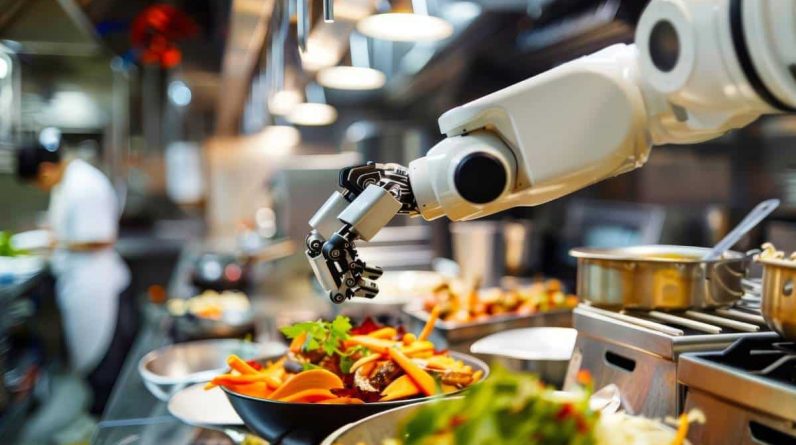
AI-powered automation is driving efficiency across many industries, most notably in manufacturing and supply chain. And as these innovations change the shape and economics of labor and cost of goods sold, there are some industries that are years away from being able to take advantage. Despite the restaurant industry having no shortage of kitchen and back-of-house use cases for automation, they don’t yet have a seat at the table. With QSR kitchen operations being such a great fit for automation and efficiency, why aren’t there more scaled examples of robots and other automated tools finding their way into makelines in kitchens across the globe?
Scalable solutions aren’t on the menu yet
Automating food preparation has serious cost control potential, and there are lots of players working on this kind of kitchen automation. For example, one QSR chain piloted automated bowl preparation at two stores, using a vendor solution that can make up to 500 bowls per hour. The chain then announced plans to roll out the technology to as many as 11 locations. However, that represents a small percentage of the company’s more than 200 locations, and it’s unclear what the timeline might be for scaling up across the enterprise, especially as the company plans to add hundreds more locations.
Another vendor in the restaurant kitchen automation space has raised $125 million for its robotic burger flipping technology. Flipping burgers is a repetitive movement that doesn’t take long but having a robot on duty that doesn’t get tired or need breaks can help with staffing shortages. That vendor has also developed a robotic fry station to prepare French fries, onion rings, and similar menu items. However, the rollout has been slow, with only 13 QSR locations piloting the new tech as of early 2025.
When will truly scalable kitchen automation reach the market? We’ve been waiting years for the tipping point: automation technology that’s successfully deployed across 30 percent of a company’s locations. Once a QSR or fast casual chain hits the 30 percent mark, rolling out the technology to the remaining 70 percent of locations should happen relatively quickly.
Small movements pose a big challenge for restaurant automation
Right now, there are two major challenges to restaurant kitchen automation at scale. The first is articulation, the ability of robots to mimic the fine-motor movements that many food preparation tasks require. For example, think of how many different movements go into the preparation of a made-to-order deli sandwich, a custom pizza, or plated meal. Arranging buns, placing chicken breasts or hamburger patties, adding condiments and other fixings may seem like simple tasks but for now, they’re tasks that machines can’t do.
When machines can manage those tasks, it will open pathways for major efficiency gains and cost savings. However, even outside the restaurant automation space, major technology companies and academic engineers are still investing resources and money to find a way to replicate that kind of articulation. Mimicking human hand movement is one of the most complex and difficult challenges in robotics even under pristine lab conditions. That means it could be a while before we get robotic arms or humanoid robots with human-like fine motor skills that are built for hot, humid, and greasy commercial kitchen environments.
Reimagining restaurant processes for automation
Overcoming the technical challenges of scalable articulation is just the first step in getting the most value from kitchen automation. The second equally important step is to re-engineer the restaurant’s operating model to accommodate and leverage that automation, whether it takes the form of a robot or something else, like a conveyor-based builder.
How those processes are defined and how the available square footage is used will depend on business goals for that particular store. For example, if the location’s primary focus is digital delivery or takeout orders, the priorities will likely be order speed and accuracy, strict cost control, and leveraging automation for labor model optimization. However, if the primary goal is to improve end-to-end customer experience, automation might be employed only to the extent that employees can be reassigned from kitchen tasks to customer-facing roles, or to other back-of-the-house tasks that improve CX.
Redesigning how the restaurant works may also require additional training for employees to take on new tasks and work alongside the automation. It’s also important to plan for quality checks as the new processes take effect, to ensure that orders and service maintain or surpass existing standards.
Invest and experiment or “wait and see?”
Even though there’s few (or no) clear examples of large-scale kitchen automation yet in the market, some leaders in restaurant operations are still willing to experiment in small pilots and POCs while others don’t want to do anything. It’s important to avoid making decisions based on fear that a competitor might be first to market on an important innovation. The most strategic play right now is to closely monitor progress in the industry without feeling compelled to invest in trendy new products that generate media buzz but lack the potential to scale. It’s also wise to have a thoughtful approach rather than developing proprietary solutions that can burn through capital, require outside expertise, and have longer term ROI.
There is a place for strategic experimentation. As automation and AI (models, agents, and physical AI) evolve there will be more compelling solutions that will align with your goals. Recent advancements in humanoid robotics platforms are getting closer with every version to the speed, accuracy, and articulations of human labor. But realizing promise means understanding the intersection of potential solutions with your menu, makeline and kitchen processes, labor model, and customer experience strategy. The right path to adoption and scale will depend on how nimbly you can land changes in your operations and when to invest.
There are several fundamental questions you need to ask. Can a new solution help you sustainably reduce labor & food costs, increase sales, or improve CX in meaningful enough ways to offset the cost of change? Can you accurately capture the costs of the implementation of the automation and the benefits to determine near-term ROI? When is the right time to invest? Is that investment enough to establish an exclusive partnership with a manufacturer before your competitors?
The next 3–5 years in robotics and automation are likely to deliver both consumers and non-manufacturing firms more transformative capability than in the past ten or more years. Regardless of the form this innovation takes, the winners in the restaurant industry will be those that are innately aware of the flexibility and adaptability of their menus, kitchen and makeline processes, and the available space to implement into their kitchens or makelines.
Mike Haddon leads Capgemini Invent’s North America Consumer Products, Retail & Services practice. He helps Fortune 500 companies achieve profitable growth by aligning strategic engagements across operations, marketing, supply chain, and commerce (stores & digital). Mike focuses on measurable business outcomes, guiding clients toward sustainable growth and value realization through blending modern technology and disciplined business execution. His work bridges strategy, technology, and scaled implementation to create enterprise-wide impact.






